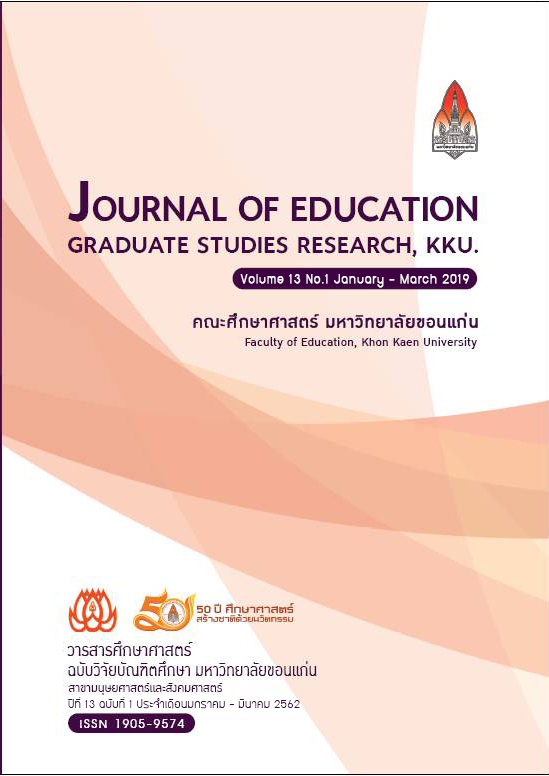The Result of Learning Management in Visual Art Subject of Art and Fashion Design by Flipped Classroom Concept and Project-Based Learning for Grade 10 Students
Main Article Content
Abstract
The objectives of this research are to 1) study the result of learning management in Visual Art Subject according to the flipped classroom concept along with the project-based learning of 10th grade 16-students and 2) study the 16-students’ satisfaction in the learning management in Visual Art Subject according to the flipped classroom concept along with the based-project learning of 10th grade students from the Demonstration School of Khon Kaen University (Mor Dindaeng), the Department of Secondary Education, Khon Kaen University, in the semester 2 of the academic year 2016. This is the initially experimental research in the single group evaluated after learning. The research tools are 1) ten learning plans according to the flipped classroom concept along with the project-based learning in arts and costumes in 20 hours, 2) five self-learning media, 3) six worksheets for creativity, 4) the evaluation form and the evaluation criteria and 5) two questionnaires of the students’ satisfaction in their teachers and the learning management. The statistics used in this research were average, percentage and standard deviation. The research findings revealed that:
1) The result of learning management in Visual Art Subject showed that the students got the score of creativity considered 86.50 percent, and all of the students were qualified considered 100 percent according to the specified criteria.
2) The students’ satisfaction was at a very high level ( x̄= 4.54, S.D. = 0.20). When considering in each factor, the teacher’s quality showed that the satisfaction was at a very high level ( x̄ = 4.56,
S.D. = 1.89), and the learning management showed that the satisfaction was at a very high level ( x̄= 4.52, S.D. = 2.22).
Article Details
References
ณัฐกร สงคราม. (2553). การออกแบบและพัฒนามัลติมีเดียเพื่อการเรียนรู้. กรุงเทพฯ: จุฬาลงกรณ์มหาวิทยาลัย.
พิมพันธ์ เดชะคุปต์. (2557). การจัดการเรียนรู้ในศตวรรษที่ 21. กรุงเทพฯ: จุฬาลงกรณ์มหาวิทยาลัย.
วิจารณ์ พานิช. (2555). วิธีการสร้างการเรียนรู้เพื่อศิษย์ในศตวรรษที่ 21. กรุงเทพฯ: มูลนิธิสดศรีสฤษดิ์วงศ์.
ศิริพงษ์ เพียศิริ และคณะ. (2551). การพัฒนารูปแบบการจัดการเรียนรู้ทัศนศิลป์เพื่อพัฒนาความคิดสร้างสรรค์. ขอนแก่น: คณะศึกษาศาสตร์ มหาวิทยาลัยขอนแก่น.
สุทธิพร จิตต์มิตรภาพ. (2553). การเปลี่ยนแปลงโลกของการเรียนรู้ในศตวรรษที่ 21 และการพัฒนาสมาคมเครือข่ายการพัฒนาวิชาชีพอาจารย์และองค์กรอุดมศึกษาแห่งประเทศไทย. กรุงเทพฯ: สำนักงานคณะกรรมการการอุดมศึกษา กระทรวงศึกษาธิการ.
สุภาพร สุดบนิด. (2556). การเปรียบเทียบความรับผิดชอบต่อการเรียน เจตคติต่อการเรียนและผลสัมฤทธิ์ทางการเรียน วิชาวิทยาศาสตร์ของนักเรียนชั้นมัธยมศึกษาปีที่ 1 ที่ได้รับการจัดกิจกรรมการเรียนรู้ ตามแนวคิดห้องเรียนกลับทาง (Flipped Classroom) และการจัดกิจกรรมการเรียนรู้แบบปกติ. วิทยานิพนธ์ การศึกษามหาบัณฑิต สาขาวิชาวิจัยและประเมินผลการศึกษา บัณฑิตวิทยาลัยมหาวิทยาลัยมหาสารคาม.
Jonathan Bergmann and Aaron Sams. (2012). Flip Your Classroom: Reach Every Student in Every Class Every Day. แปลโดย รุ่งนภา นุตราวงศ์. (2556). กรุงเทพฯ: สำนักงานคณะกรรมการการศึกษาขั้นพื้นฐาน กระทรวงศึกษาธิการ.

